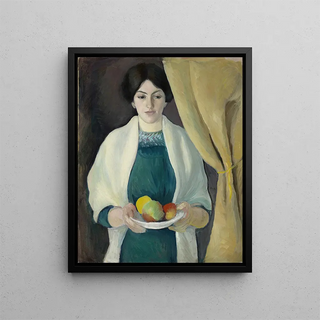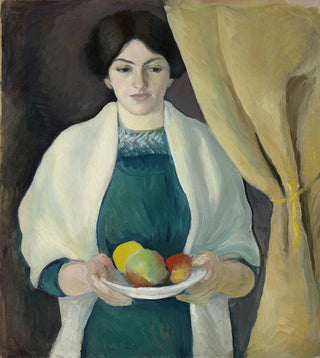Art print | Portrait with Apples - August Macke


View from behind

Frame (optional)
Portrait with Apples - August Macke – Captivating Introduction
In the vibrant world of modern art, few works manage to capture the essence of everyday life with as much poetry as "Portrait with Apples" by August Macke. This canvas, created in 1911, belongs to the expressionist movement, where color and form transcend reality to offer a deeper vision of human existence. By contemplating this piece, the viewer is invited to immerse themselves in a world where everyday objects, such as these radiant apples, become symbols of joy and vitality. The dancing light on the surfaces, the vivid colors, and the harmonious composition create an atmosphere that is both intimate and universal, revealing art's ability to evoke emotions.
Style and uniqueness of the work
"Portrait with Apples" stands out for its bold use of color and balanced composition. Macke, a true alchemist of shades, plays with vivid nuances and striking contrasts to infuse his painting with palpable energy. The apples, in a bright red, are carefully arranged, but they are not merely decorative elements; they are the very heart of the composition, drawing the eye and inviting deeper contemplation. The stylized forms and delicate contours reflect an aesthetic pursuit aimed at transcending realism, capturing the very essence of objects. In this way, the work presents itself as an ode to everyday beauty, celebrating simplicity while inviting reflection on the very nature of art and perception.
The artist and his influence
August Macke, an emblematic figure of the German expressionist movement, made his mark with an innovative approach to painting. Born in 1887, he quickly developed a unique style, blending Impressionist and Fauvist influences to create a distinctive aesthetic. His passion for color and light is evident in many works, but "Portrait with Apples" remains one of the most revealing examples of his creative genius. Macke was also influenced by his travels, notably in Tunisia, where he discovered new palettes and cultural motifs that enriched his work. His legacy, though tragically interrupted

Matte finish

View from behind

Frame (optional)
Portrait with Apples - August Macke – Captivating Introduction
In the vibrant world of modern art, few works manage to capture the essence of everyday life with as much poetry as "Portrait with Apples" by August Macke. This canvas, created in 1911, belongs to the expressionist movement, where color and form transcend reality to offer a deeper vision of human existence. By contemplating this piece, the viewer is invited to immerse themselves in a world where everyday objects, such as these radiant apples, become symbols of joy and vitality. The dancing light on the surfaces, the vivid colors, and the harmonious composition create an atmosphere that is both intimate and universal, revealing art's ability to evoke emotions.
Style and uniqueness of the work
"Portrait with Apples" stands out for its bold use of color and balanced composition. Macke, a true alchemist of shades, plays with vivid nuances and striking contrasts to infuse his painting with palpable energy. The apples, in a bright red, are carefully arranged, but they are not merely decorative elements; they are the very heart of the composition, drawing the eye and inviting deeper contemplation. The stylized forms and delicate contours reflect an aesthetic pursuit aimed at transcending realism, capturing the very essence of objects. In this way, the work presents itself as an ode to everyday beauty, celebrating simplicity while inviting reflection on the very nature of art and perception.
The artist and his influence
August Macke, an emblematic figure of the German expressionist movement, made his mark with an innovative approach to painting. Born in 1887, he quickly developed a unique style, blending Impressionist and Fauvist influences to create a distinctive aesthetic. His passion for color and light is evident in many works, but "Portrait with Apples" remains one of the most revealing examples of his creative genius. Macke was also influenced by his travels, notably in Tunisia, where he discovered new palettes and cultural motifs that enriched his work. His legacy, though tragically interrupted






